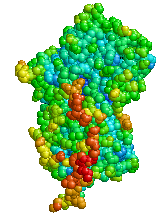Alpha 1-antitrypsin
|
|
| Contents |
Function
A1AT is a 52 kDa serine protease inhibitor, and in medicine it is considered the most prominent one, given the fact that the words α1-antitrypsin and protease inhibitor (Pi) are often used interchangeably.
Most serpins inactivate enzymes by binding to them covalently, requiring very high levels to perform their function. In the acute phase reaction, a further elevation is required to "limit" the damage caused by activated neutrophil granulocytes and their enzyme elastase, which breaks down the connective tissue fiber elastin.
Like all serine protease inhibitors, A1AT has a characteristic area of secondary structure including beta sheets and alpha helices. It is in this area where mutations can lead to polymerisation and accumulation in the liver.
Role in disease
Disorders of the enzyme include alpha 1-antitrypsin deficiency, a hereditary disorder in which lack of alpha 1-antitrypsin leads to uninhibited tissue breakdown during inflammation. This causes pulmonary emphysema and leads to liver cirrhosis in severe cases.
A remarkable form of Pi, termed PiPittsburgh, functions as an antithrombin (a related serpin), due to a mutation (Met358Arg). One patient with this abnormality has been described; he died of a lethal bleeding diathesis. This disorder proves the point that the serine protease inhibitors have a closely related structure.
Nomenclature
The enzyme is called "antitrypsin" because of its ability to covalently bind and irreversibly inactivate the enzyme trypsin. (Trypsin, a type of peptidase, is a digestive enzyme active in the duodenum and elsewhere.)
The term "alpha 1" refers to the enzyme's behaviour on protein electrophoresis. On electrophoresis, the protein component of the blood is separated by electric current. There are several "clusters", the first being albumin, the second being the alpha, the third beta and the fourth gamma (immunoglobulins). The non-albumin proteins are referred to as globulins.
The alpha region can be further divided into two sub-regions, termed "1" and "2". Alpha 1-antitrypsin is the main enzyme of the alpha-globulin 1 region.
Another name used is alpha-1 proteinase inhibitor (α1-PI).
Genetics
The gene is located on the long arm of the fourteenth chromosome (14q32.1).
Over 80 different versions of α1-antitrypsin have been described in various populations. North-West Europeans are most at risk for carrying a deviant form of A1AT.
Analysis
As protein electrophoresis is imprecise, A1AT is analysed by electrofocusing (isoelectric focusing analysis), where the protein is passed along a pH gradient.
Normal A1AT is termed "M", as it is neutral and does not run very far. Other variants are less functional, and are termed A-L and N-Z, dependent on whether they run more proximal or more distal to the M band. The presence of deviant bands on electrofocusing can signify the presence of alpha 1-antitrypsin deficiency.
As every person has two copies of the A1AT gene, a heterozygote (with two different copies of the gene), will have two different bands showing on electrofocusing.
In blood test results, the electrofocusing results are notated as in PiMM, where Pi stands for protease inhibitor and "MM" is the banding pattern of that patient.
Alpha 1-antitrypsin levels depend on the phenotype, as deviant forms are excreted inefficiently by the liver and polymerise in the endoplasmic reticulum:
- PiMM: 100% (normal)
- PiMS: 80%
- PiSS: 60%
- PiMZ: 60%
- PiSZ: 40%
- PiZZ: 10-15% (severe alpha 1-antitrypsin deficiency)
The non-M alleles are all the product of mutations in the "normal" (wild type) M variant.
- PiZ is caused by a glutamate to lysine mutation on position 342.
- PiS is caused by a glutamate to valine mutation on position 264.
- Other, rarer forms have been described; in all, there are over 80 variants.
Therapeutic use
Recombinant alpha 1-antitrypsin is not yet commercially available, but is under investigation as a therapeutic modality in congenital deficiency. Therapeutic concentrates are prepared from the blood plasma of blood donors.
History
The possibility of allelic variants of A1AD leading to disease was first investigated by Dr U. Axelsson and Dr C.B. Laurell in 1965.
Sources
- Axelsson U, Laurell CB. Hereditary variants of serum alpha-1-antitrypsin. Am J Hum Genet 1965;17:466-472. PMID 4158556.
- DeMeo DL, Silverman EK. α1-Antitrypsin deficiency; 2: Genetic aspects of α1-antitrypsin deficiency: phenotypes and genetic modifiers of emphysema risk. Thorax 2004;59:259–264. DOI 10.1136/thx.2003.006502 (http://dx.doi.org/10.1136/thx.2003.006502).
- Gettins PG. Serpin Structure, Mechanism, and Function. Chem Rev 2002;102:4751-4803. DOI 10.1021/cr010170+ (http://dx.doi.org/10.1021/cr010170+).
External links
- Template:OMIM
- Swiss-Prot P01009 (http://ca.expasy.org/cgi-bin/niceprot.pl?P01009)fr:Alpha 1-antitrypsine

